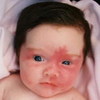Physical Assessment of the Newborn Flashcards
(59 cards)
When should the initial assessment be done?
in the delivery room to detect significant anomalies, birth injuries, and cardiorespiratory disorders that may compromise a successful adaptation to extrauterine life.
When should the next physical assessment be done?
A more detailed exam should take place in the nursery before the infant’s status is discussed with the parents, within 12-18 hours after birth.
When should a final physical assessment be performed
within 24 hours of discharge.
Skin Assessment
The skin should be soft, smooth and opaque. Vernix caseosa may be present. In a post-term infant, the skin may be dry and peeling. The skin should be warm to touch. Petechiae may be seen over the head/neck or above nipple line secondary to pressure from a nuchal cord.
Vernix Caseosa
whitish greasy material that covers the fetus’s body after 35 weeks gestation, then it decreases in quantity as it is shed into the amniotic fluid with increasing gestational age.

What does discolored vernix caseosa mean
it occurs with hemolytic disease and meconium stating as a result of in utero fetal distress.
skin color plethora
deep rosy red more common in infants with polycythemia, but also in an infant who is over oxygenated or overheated. Obtain a venous HCT.

jaundice
yellow color - bilirubin levels in the blood are usually > 5 mg/dl. This abnormal in infants <24 hr old and may signify a blood incompatibility or infection.

pallor
washed-out or pale skin color; may be secondary to anemia, birth asphyxia, or shock.
Cyanosis
blue or dusky appearance of the skin; reduce O2 sats < 85%; most difficult task with cyanotic neonates is recognizing the cyanosis; best observed when they are quiet, sleeping in a thermoneutral environment under a white light; examine the tongue, oral and buccal mucosa, and peripheral skin.

Peripheral cyanosis
cyanosis of the extremities; “vasomotor instability”; acrocyanosis; may be due to a cold environment, high HCT, local obstruction, or may persist for days, even weeks.

Central cyanosis
cyanosis of the mucous membranes and periphery due to the presence of 3g/dL or more of reduced Hg in arterial blood. May indicate a pathologic condition; persistent central cyanosis always requires immediate eval. Causes of cyanosis can range from trivial to life-threatening.
Extensive bruising at birth
is associated with traumatic birth and may result in early jaundice.

Milia
multiple yellow or pearly white 1 mm papules, scattered on the chin, nose, forehead, and cheeks. Benign, representing tiny epidermal cysts in connection with the sebaceous follicle. Disappear within a few weeks.

sebaceous gland hyperplasia
tine white or yellow lesions visible at the opening of each pilosebaceous follicle. More prominent on the nose, upper lip, and malar regions. Represent hyperplastic sebaceous glands. Spontaneously diminish in size after birth and no longer visible.

erythema toxicum
Numerous small areas of red skin with a yellowish white papule in the center. Noticeable at 48 hours but can appear as late as 7 days. Resolves spontaneously within 4-5 days after the appearance. (Can be confused with candida dermatitis, miliaria rubra and pustular melanosis)

Mongolian spot
dark blue or purple macular spots resembling bruises, usually located over the lumbosacral area. 90% of African Americans, Native Americans, and Asians 85% of Hispanics 5-10% of Caucasians Fade during late infancy, or at least by 4 yrs. Somer persists to adulthood.

Macular hemangioma
telangiectatic nevus nevus flammeus salmon patch stork bite A true vascular nevus is normally seen on the occipital area, eyelids, and glabella (forehead area over the eyebrows).

When do macular hemangioma’s disappear?
spontaneously within the first year of life EXCEPT those on the nape of the neck, many of which persist The most common type of birthmark, macular hemangioma occurs in 60-70% of all infants.
Harlequin phenomenon
A clear line of demarcation with an area of redness and an area of paleness. Cause is usually unknown. Most likely related to vasomotor instability. It is benign and transient, could indicate shunting of blood is occurring (as in sepsis or persistent pulmonary HTN)

Cutis marmorata
Mottling, lacy red pattern that may be seen in a normal infant or on with cold stress, hypovolemia, or sepsis. Persistent mottling is seen with a variety of chromosomal abnormalities.

Miliaria
Transient lesions that commonly occur in a warm environment as the result of obstruction of the sweat gland ducts.
Miliaria crystallinia
clear superficial tiny vesicles without inflammation

Miliaria rubra
small erythematous, grouped papules on a red base



































